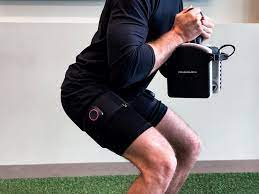Blood Flow Restriction Training
- K-Town Physio

- May 29, 2023
- 3 min read
Updated: May 30, 2023
What is Blood Flow Restriction Training?
Blood flow restriction training (BFR) is a form of exercise that involves limiting the amount of blood flow to a specific muscle during exercise. This method has become increasingly popular for post-operative and injured individuals as it has been shown to have many benefits, including increased muscle size and strength, enhanced recovery, and reduced muscle damage.

How does it work?
During BFR training, a tourniquet is applied to the injured or weak limb. This creates a restriction of blood flow to and from a targeted muscle during exercise. When blood flow is restricted, it causes a buildup of metabolic waste products, such as lactic acid, in the muscle tissue. This metabolic stress triggers a series of physiological responses, including the release of growth factors, increased activation of muscle fibers, and activations of satellite cells, which are responsible for muscle repair and growth.
By performing exercises with BFR, an individual can achieve similar results to high-intensity weight training with lighter weights. This makes BFR a viable option for individuals who are unable to perform heavy weightlifting exercises due to injury or other conditions.
Who would benefit from BFR?
BFR can be used to help post-operative and injured individuals. Here are a few examples of what conditions may benefit from BFR:
Post-operative Rehabilitation
BFR has been shown to be effective in post-operative rehabilitation, particularly for knee and shoulder surgery. It can be used to help restore muscle strength and function, and it has been shown to be more effective than traditional weightlifting in some cases. BFR can also be used to help reduce muscle atrophy, which is a common problem after surgery.
Acute/Sub-Acute Injuries
BFR has been shown to be effective in treating injuries, such as muscle strains, sprains, and tears. It can help to reduce inflammation and promote healing by increasing blood flow to the injured area. BFR can also be used to help maintain muscle strength and function during injury, preventing muscle atrophy and helping to speed up the recovery process.
Chronic injury/muscle deconditioning
BFR can be used safely to help build muscle strength in individual who may not be able to tolerate high loads. Low intensity exercise can be used in order to avoid excessive stress on painful joints.

Are there any risks to using BFR?
Due to the need for partial blood flow restriction, BFR should not be used in individuals with certain pre-existing medical conditions including: Cardiovascular disease, blood disorders, deep vein thrombosis (DVT), peripheral neuropathy and pregnancy.
How long does it take?
The number of sessions required to see results from blood flow restriction (BFR) training can vary depending on several factors, including:
1. Type of injury or condition: The amount of time it takes to see results from BFR will depend on the type of injury or condition being treated.
2. Frequency of BFR: The frequency of BFR sessions can affect the speed of results. Generally, BFR is performed two to three times per week.
3. Duration of BFR: The duration of BFR sessions can affect the speed of results. BFR sessions typically last 15-45 minutes.
4. Individual factors: The speed of results from BFR can also depend on individual factors such as age, fitness level, and diet.
Typically, some improvement can be seen within 2-4 weeks of starting BFR, with optimal results appearing after several months of consistent training. However, the specific time frame for seeing results can vary depending on the individual and their specific needs and conditions.
In conclusion, BFR is a valuable tool for post-operative and injured individuals. It can help to increase muscle size and strength, enhance recovery, and reduce muscle damage, making it a great option for individuals who are looking to improve their overall health and fitness. However, it is important to consult with a qualified healthcare professional before starting BFR training, especially if you have had surgery or are recovering from an injury. BFR therapy should only be performed under the supervision of a trained professional and with caution, to minimize the risk of potential complications.
Currently BFR is available at our Arlington location.





